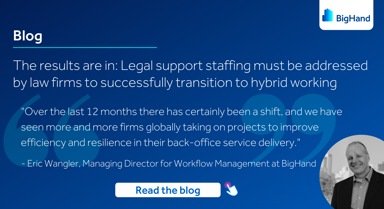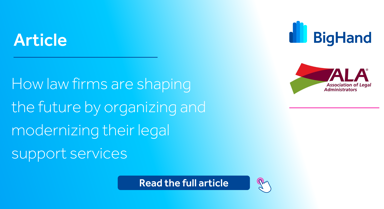Although firms are becoming more aware of support staff structures, some firms have yet to even think about how they are going to make the move from a direct relationship model to a team or process-based model. One thing remains clear, the time for change is now and this remains one of the hottest topics across every conversation in every firm that I speak with.
Back in 2019 firms were exploring new support models that were to be the future. Fast forward to present day and looking back, a significant amount of change has occurred in a very short amount of time. We saw the rise of hybrid working in 2020 and it forced firms to work in a very different way. In this new working dynamic, staff were no longer right outside the doors of the lawyers they supported while paper driven practices had to be altered quickly to adapt a digital approach. This point in time made it abundantly clear, drastic change in the legal industry can be done quickly and effectively. The global shift to hybrid working, created some very interesting possibilities, and opened the door for more efficient procedures as firms started operating a centralized support team structure rather than relationship-based model where tasks aren’t delegated fairly. Although we’ve already seen huge changes, some support staff models will still need development as firms move forward through the fast-paced market changes that are driven by client demands, retention pressures and recruiting challenges.
Many firms are now thinking more creatively than ever given the immense pressures they are facing in staffing tasks more efficiently with 71% of NA and 63% of UK firms saying that they have received pressure from clients to make sure legal work is completed by the most cost-effective resource. With clients becoming more conscious of how their legal work is being completed, firms must respond, and while many are looking to return to the office and ‘business as usual’ they must embrace the ‘new normal’ and support a flexible working model with workflow management technology. In the face of changing employee expectations and a greater focus on work/life balance, firms should be concerned by the continued reliance on manual processes for task delegation. 55% of NA and 48% of UK respondents have said they would look for a new job if required to work more than three days in the office. With attrition rates already increasing, can firms afford to lose more talent? With this new normal, firms must continue to evolve support structures and plan for a new generation of support staff.
With all these issues occurring simultaneously, it leaves many firms thinking about where they even start. When you look at the road ahead, it can seem extremely daunting, but many firms are leading the way in evolving their support structures and have paved the road for others to start their journey. I have spent a lot of direct time with firms who have centralized their support models and although implementation can vary firm to firm, there are some general questions all firms should reflect upon when starting out.
Where does your firm stand on hybrid working?
Work can be done from anywhere, you just need to define it, separate it, monitor it, report on it and definitely use hybrid working as your “carrot” as you moved toward a new support model! Ensure that you are market competitive in hybrid working to ensure that you can retain and attract top talent.
Is your current support model sustainable, or do you need additional changes?
Support staff changes have been on law firm agendas for years, but both lawyers and support staff are still constrained by a lack of information and processes to support effective task allocation and management and need improved data visibility.
How can you create a sense of urgency with firm leadership?
Many experienced individuals have left the industry; others have moved to firms with a more compelling employment opportunity – from higher salaries to more flexible working and better career development. The result is that firms are now desperately concerned about safeguarding experience and expertise across the board. As a result, highly paid lawyers are compelled to undertake additional administrative (non-billable) tasks to the detriment of their fee earning capabilities, billable hours and morale.
The legal support role is changing. How can you get ahead?
Ensure that support staff have access to the additional training required to build an extended skill set that includes competence with technology. Consider that the role of a Legal Assistant may be evolving to a new level as many firms introduce Executive Assistants which creates an attractive career development path.
We have seen so much change in the past three years which has attributed to change fatigue and has made the move towards a new support model difficult for many firms. The key is to just start somewhere, find even the smallest win, leverage that and build your momentum from there. Create a sense of urgency around this topic by educating firm management on key market drivers. The new normal for support staff models is a reality and the time for change is now.
For more information on how firms can support an efficient hybrid support structure, download a copy of the latest Legal Workflow Management Report.






